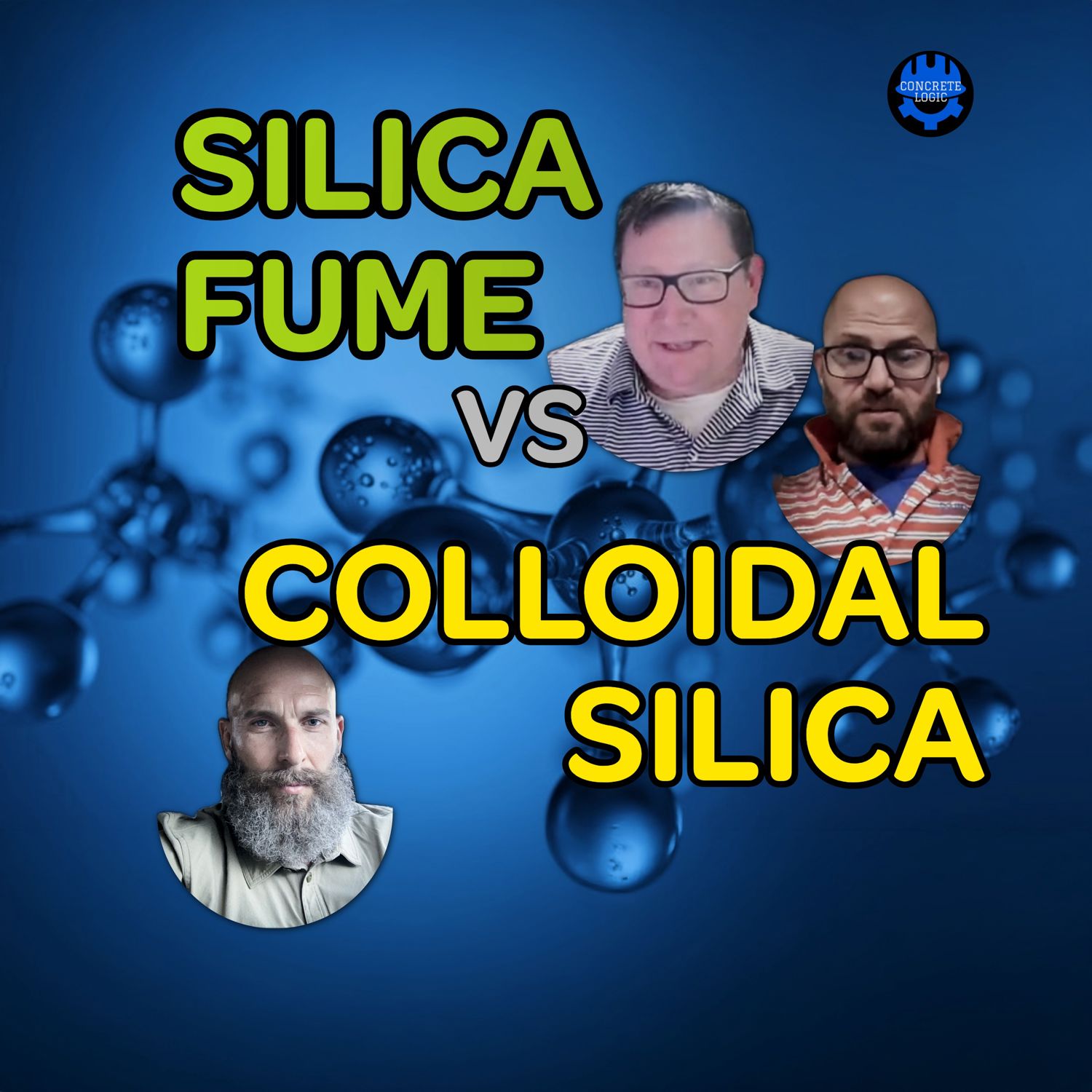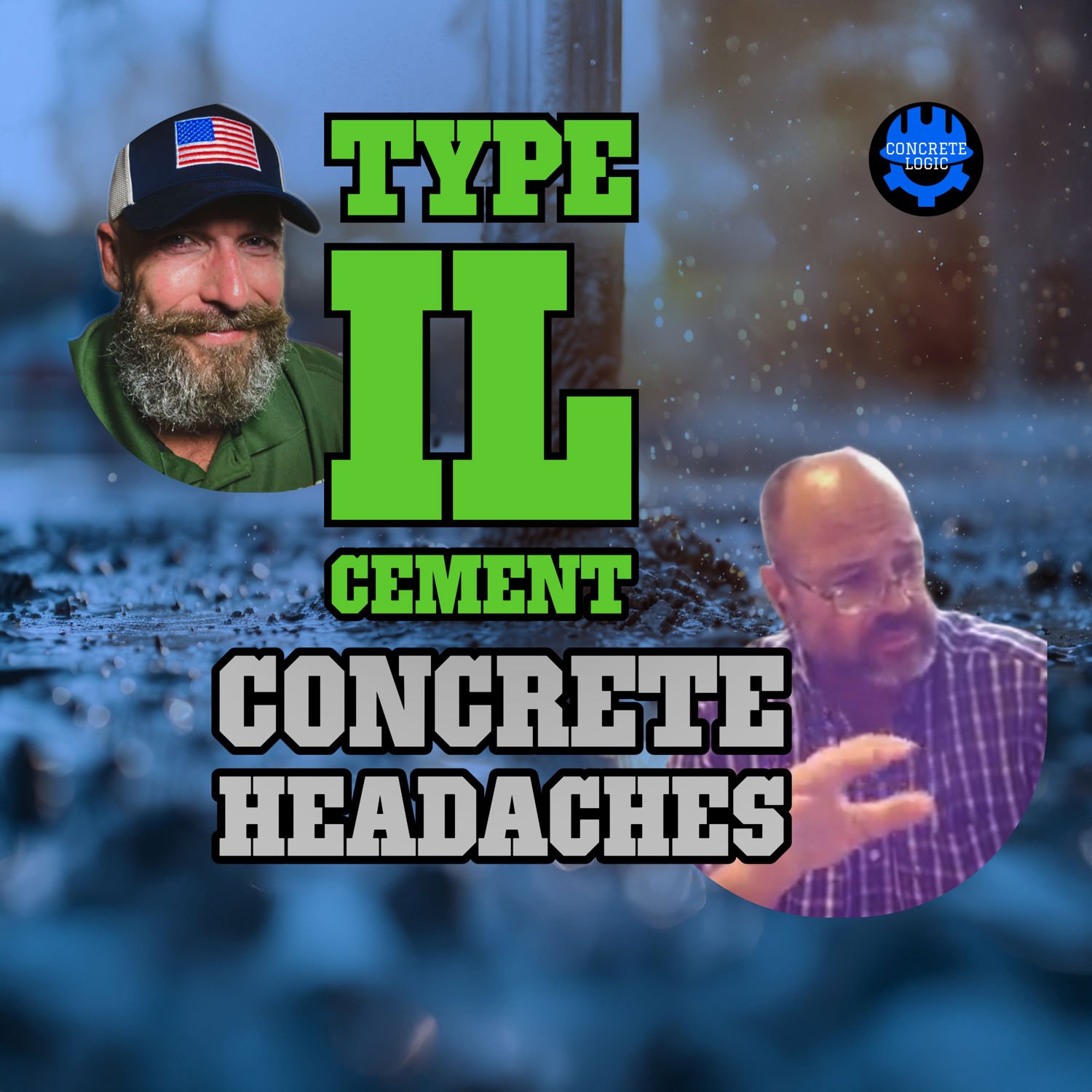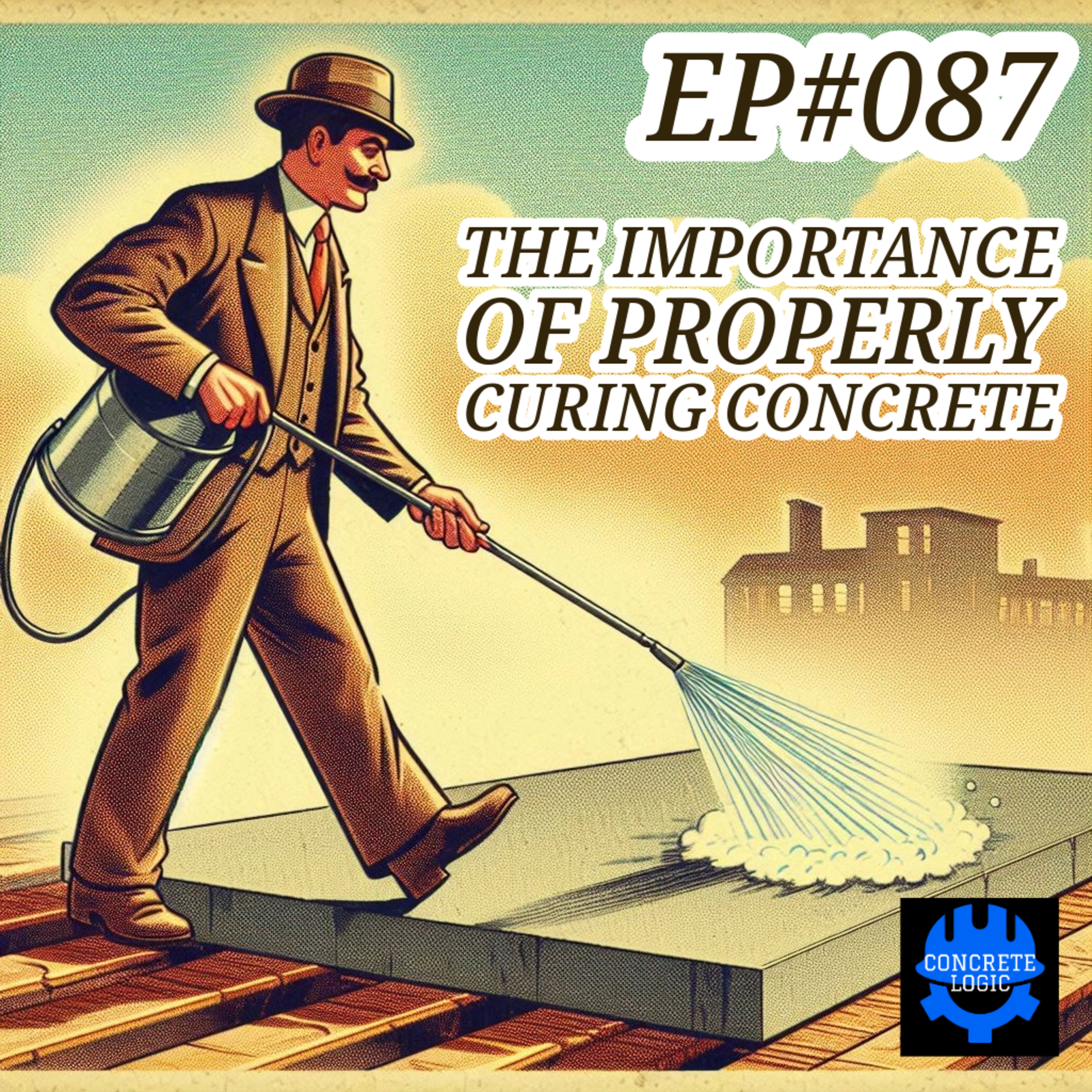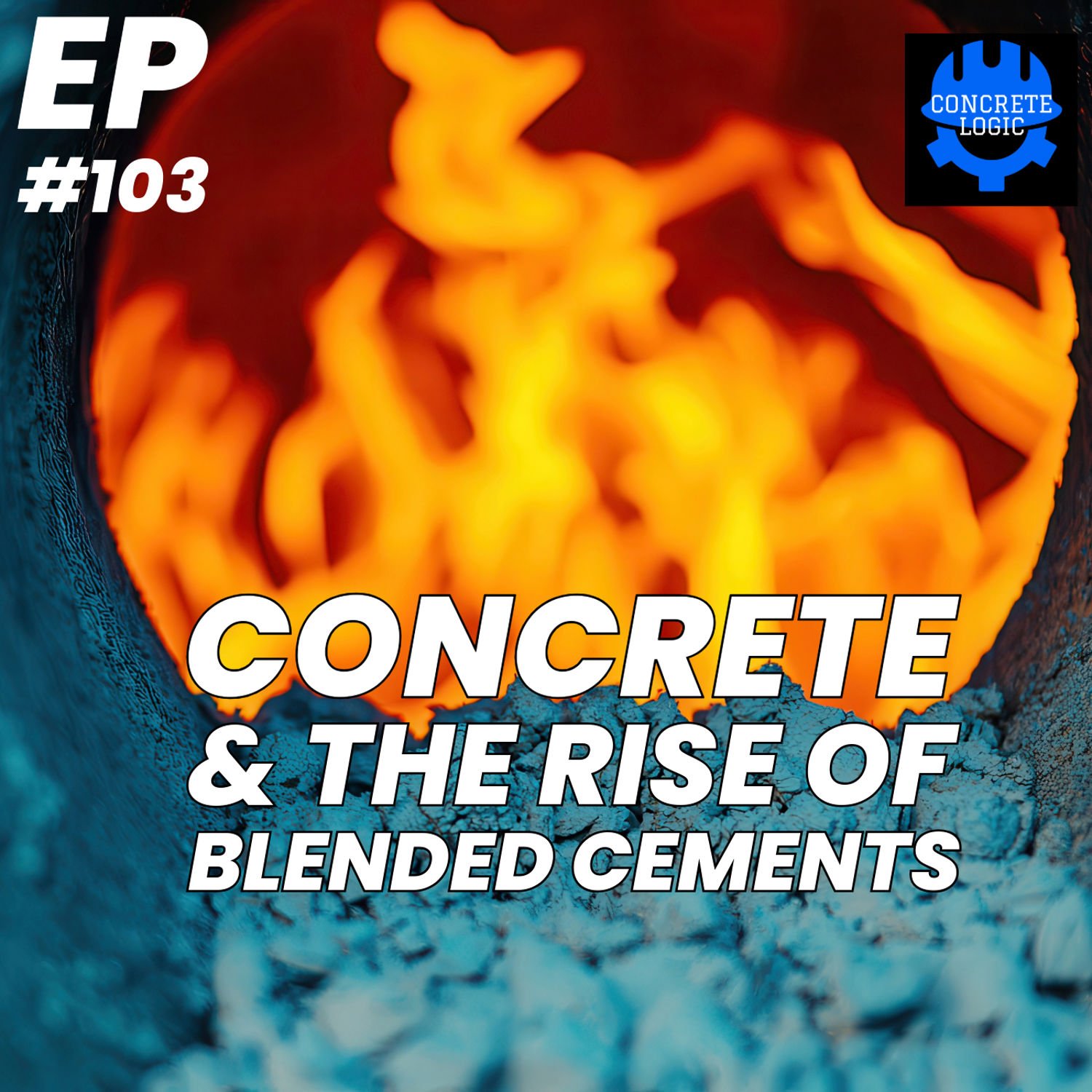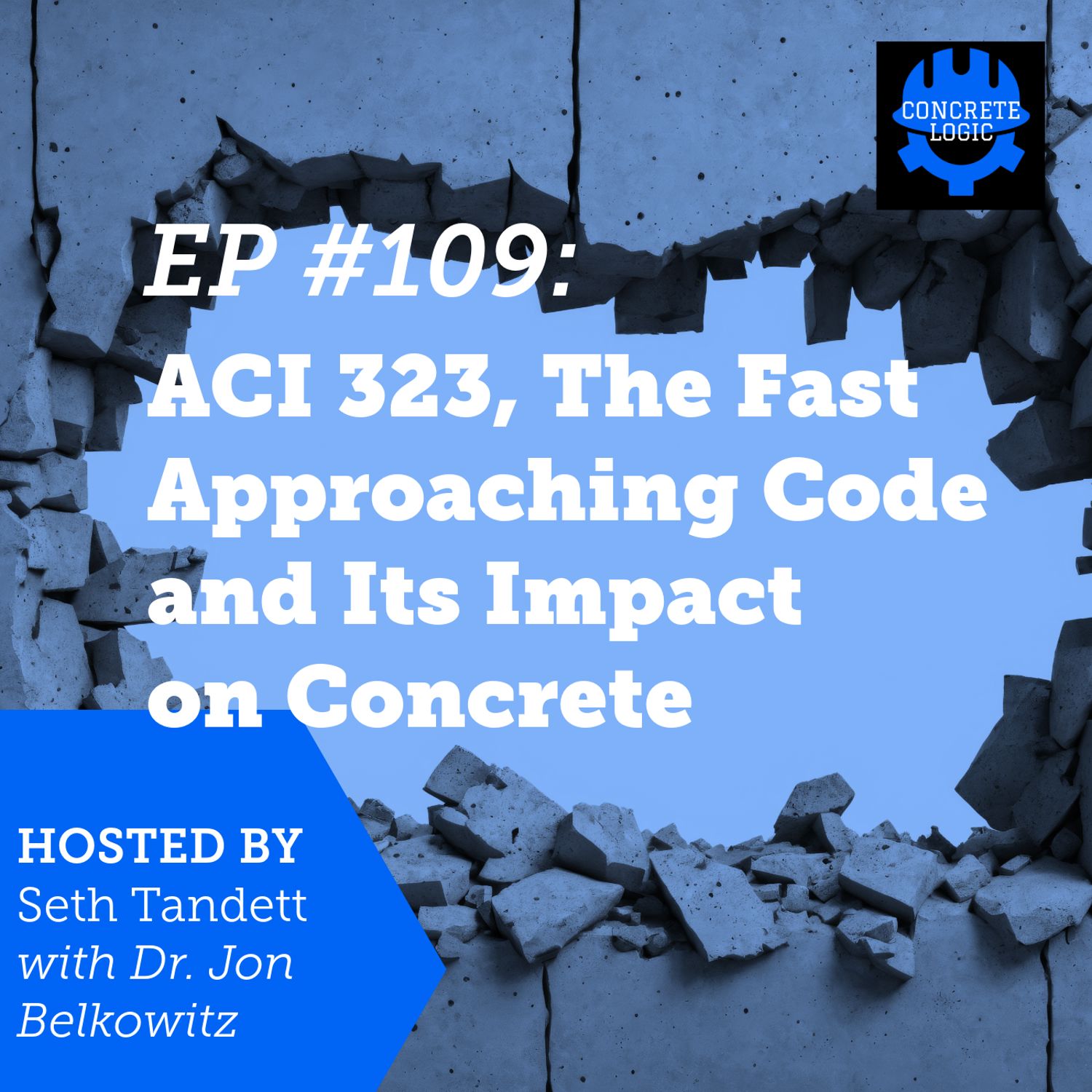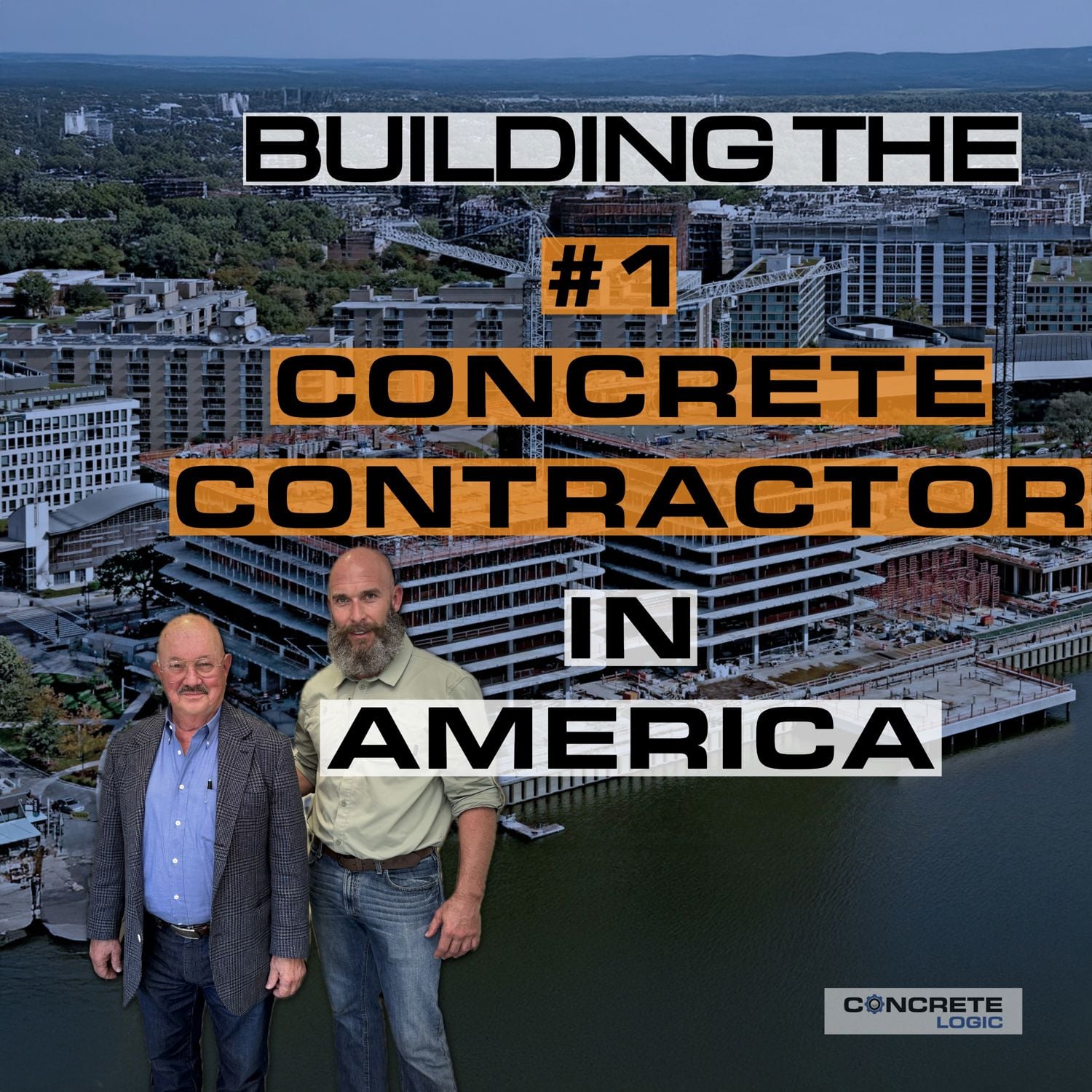EP #130: Concrete Failing with Type IL? It Might Be the Admixtures, Not the Cement

Everyone’s pointing fingers at Type IL cement, but what if your admixtures are the real problem?
In this episode, Dr. Jon Belkowitz returns to the Concrete Logic Podcast to challenge the one-to-one replacement myth and shine a light on the role of admixture compatibility. If your concrete is failing early—or your team is just managing problems instead of solving them—this episode is a must-listen.
What You’ll Learn:
- Why do so many people still believe Type IL is a one-to-one replacement?
- What’s the real impact of outdated admixtures on today’s cement?
- How do compatibility tests help prevent concrete failures?
- Why are some producers thriving with Type IL while others are falling behind?
- What questions should ready-mix suppliers be asking their admixture reps?
- Are outdated specifications setting projects up to fail before they start?
- How is complacency contributing to early-age concrete failures?
Chapters:
00:00 – Dr. Jon Returns from a New Lab
01:28 – Is Type IL Really Here to Stay?
02:52 – “Type IL Is Here… Unless You’re Willing to Pay”
03:41 – It’s Not the Enemy—but It’s Also Not One-to-One
05:36 – We’ve Been Here Before: Lessons from Cement History
08:00 – Admixtures and Compatibility: What’s Changed?
09:49 – Why Some Ready-Mix Producers Are Struggling
11:40 – The Industry’s Selective Memory
14:33 – What We Used to Do (and Should Again)
16:20 – “The Cracks Just Go Away” – Really?
17:45 – Were the Specs Set Up to Fail?
20:27 – Complacency Is Killing Concrete
22:21 – Selling the 1:1 Myth
24:31 – Systemic Failure, Not Isolated Issues
25:48 – Admixture Air Issues, Surface Failures, and Octopus Talk
26:36 – Time to Rethink Our Admixture Strategies
28:41 – All Admixture Companies Can Help—So Why Aren’t We Asking?
30:09 – You Might Have a Problem…
30:30 – Are We the Third Generation Screwing It All Up?
31:58 – Final Message: Start With the Admixtures
Guest Info:
Dr. Jon Belkowitz
Director of Research, Intelligent Concrete
Email: jon@intelligent-concrete.com
Website: https://www.intelligent-concrete.com
Learn with Concrete Logic Academy
NEW PDH Course Available! Civil Engineering Business Ethics — 1-hour credit.
Take your first class FREE at: www.concretelogicpodcast.com/academy
Support the Podcast
Want to drive innovation and uncomfortable (but important) conversations in the concrete industry?
Become a Producer by Donating Here: www.concretelogicpodcast.com/donate
Your name will be listed in the episode credits!
Credits:
Host: Seth Tandett
Producers: Matt Gross, Jodi Tandett & Concrete Logic Media
Music: Mike Dunton (Instagram: https://www.instagram.com/mikedunton)
Connect with Us:
Host on LinkedIn: https://www.linkedin.com/in/sethtandett/
YouTube: https://www.youtube.com/@concretelogicpodcast
Website: https://www.concretelogicpodcast.com
Like what you hear? Like, subscribe, comment, and share this episode.
#letskeepitconcrete
Seth Tandett (00:00)
And welcome to another episode of the Concrete Logic Podcast. And today have our favorite guest, Dr. Jon Belkowitz. And he's in his new location.
Dr Jon (00:08)
Go concrete.
I am. And it's 71 to 77 degrees here with 50 % plus or minus, 4 % relative humidity. Wonderful dew point. We've got loss of moisture between 8 and 13 milliliters in a 24-hour period.
We're ready for CCRL.
Seth Tandett (00:32)
None of that made sense to me except for it was in the 70s. That's what I heard. Yeah, that's great. Yeah, so it's been a bit since you've been on. We tried to get you on with Rich and we had some technical difficulties, but I'm glad we got it figured out. what we're going to do today is continue-ish that topic at hand where we were
Dr Jon (00:38)
It's beautiful in here.
ish.
Seth Tandett (00:58)
We were discussing Type 1L. Rich's episode, if you didn't catch it, I believe it was 127. And I think it was. Something like that. You'll find it. Just look it up. When we were talking about why some folks were having problems with Type 1L cement and why some folks were having problems and why others were not. And we're going to discuss that today with
Dr Jon (01:17)
you
Seth Tandett (01:28)
Dr. did you want to start with the type 1L is here to stay, or do you want to start somewhere else?
Dr Jon (01:35)
Yeah,
yeah, yeah, yeah. think, you know, Rich says, and he has said it awesome, that Type 1L is here to say, did he say that during the last podcast? Okay.
Seth Tandett (01:46)
Not the last one. think it was several,
ago. And then Tyler, to be fair, I think Tyler Lay has been on the podcast and said the same thing. So there's been a couple of individuals on here. I think you're, and I just want to recognize that you've been on this podcast and say, that is not the case.
Dr Jon (02:00)
Yeah.
I just want to amend it. I don't want to be negative and say that's not the case. I just want to, I like words, you know, especially since we were just talking about writing in script or cursive. ⁓ But the English language is very important to me. And I think saying that type 1L is here to say, stay, almost sounds like a threat or a promise. It has a negative connotation to it. And if, if...
Seth Tandett (02:20)
yeah.
Dr Jon (02:35)
If you just add two or three more words at the end, all of a sudden it has this like positive, you know, swing to it. So I just want to amend it to not type 1L is here to stay. Type 1L is here unless you're willing to pay a little more money. And then you could use whatever the fuck you want. Excuse my language. But that's just, that's the truth. Because what?
Seth Tandett (02:52)
You're good.
Yeah.
Dr Jon (02:57)
Esco, Sylvie, Ozinga. I mean, there are plenty of companies that have been bringing cement into the US for the better part of 10, 15 years now. So to insinuate that it's either you use Type 1L or else, I don't think that's necessary. Because Type 1L is still being sold.
the despite the manifold of issues that folks are having with it, we're still, you know, managing the problems as one ready mix provider said to me, although some I would say unlike Rich or not managing or like Rich or not managing the problem, but actually focusing on dealing with the problem, how to turn the problem into a solution. And that's what I wanted to talk about today. Is that fair to do?
Seth Tandett (03:40)
Yeah, yeah, yeah.
Dr Jon (03:41)
I think one of the things that you've been seeing on your podcast is that there's a lot of defense of the type 1L or a lot of offense. It's either you love it or you hate it. I haven't listened to Rich's yet because I didn't want it to have an impact on mine.
But I've had people tell me that they've flippin loved it and as soon as we're done here I'm gonna go listen to it But I know you've had a few people on here who just bashing and trashing it and then there are people from certain organizations that are just like up It's just like normal cement
And you know, type 1L is not the enemy. And the reason why I say that is because a lot of the folks we have today in the industry are too young to remember the great cement shortage between, what is it, 96 and 98, where we weren't producing enough to meet the demand here in the US, and we started bringing in cements from overseas.
Now these cements had a higher blain fineness, they had a higher alkalinin, and because of that, instead of waiting 28 days to get 28 day strengths, we were achieving those in seven days, three days, sometimes even 24 hours. And again, I don't know if anybody remembers him, there's a gentleman named Richard Burroughs who was trying to create a type six cement.
which was reminiscent of the Hoover Dam days, were 28 days to get 28 day strength. And up until he passed away and he was what 102 years old when he was still working on it, he was the champion. It was moving through. But.
The funny thing is by the early 2000s we were starting or even the late 90s, know, 2000, we were starting to produce enough cement here in the U.S. and we went back to our traditional Hoover Dam cements. In the industry, the contractors were like, we don't want this. We want those Asian based cements that give us our strength. We can backfill in 24 hours or seven days. You know how many job sites I can move to with that?
Seth Tandett (05:35)
Right.
Dr Jon (05:36)
Now, we also didn't realize that because of the alkalinity, it was gonna cause issues with ASR and some other stuff, but we found that out over time. It's just that the industry has been through this before and we have bounced back in different ways. Now, because of logistics and because of the World Wide Web, we have made the world much smaller. And now getting cement from Vietnam, Denmark.
Greece, China, India is not a bad thing. Look at this. Check this out. We did this study on the cement market in India, and this was back in 2017. Rich did this project and gave a presentation on the great cement shortage of 2017 in Texas. That's something you should have him present on the Concrete Logic podcast.
Seth Tandett (06:21)
Yeah.
Dr Jon (06:22)
In that presentation he gave in 2010, 2012 timeframe, he talked about how we were going to eclipse the amount of cement that we needed and we'd have to start bringing in from overseas. And he was a hundred percent correct. Now I'll shut up here in a second, but check this out. These are all, hold on, those are limestone deposits, coal deposits. These are all the new areas for cement production.
in India.
Seth Tandett (06:53)
Yeah.
Dr Jon (06:55)
Like there is enough cement to go around. again, going back to the phrase, type one here, type one L is here unless you're willing to spend more money.
Seth Tandett (07:04)
Yeah. Well, especially now there's tariffs.
Dr Jon (07:07)
There's terrorists, but...
You know, the reality that people are losing concrete and if this this upsets the cement associations and the folks who are selling the type 1L, it's their own F and fault. You could be mad at me if you want to. I four kids. They're constantly mad at me. But the the rhetoric of, know, it's a one to one. And Rich gets so pissed at me when I say that. you got to stop saying that, Jon. Like, it's not me saying it. It's the ready mix providers who won't stop internalizing it in
believing it. Like listen, when I first got in the industry, we started using polycarboxylates, high range water reducers. We found out very, very quickly the type of cement, both physical and chemical characteristics, kind of had an impact on the way the polycarboxylate comb polymer worked. And here I put together this presentation. Can I show this slide?
Seth Tandett (07:38)
Yeah.
Yeah, go ahead. As long as we're staying on track, I don't want you to get off track. Stick with the type, what we're doing with type 1-L. OK.
Dr Jon (08:00)
try it we'll see what happens.
Right, so I won't, I won't do it.
But what we found, and when I say we, it's a larger part of the industry, not only did the Palikor box lit not work as well, if we're using Advil 100 in Boston, we could get a 28 inch spread with four ounces per hundred weight. We went over to Colorado, we needed eight ounces per hundred weight to get the same spread. When we went over to Albuquerque, you could use 16 ounces per hundred weight, and instead of getting a spread, you got a two inch slump.
So what we found in one of the papers that I get into is there was a wonderful paper written by Jean-Michel Lay, three pages, French guy, most of it was photos or charts and graphs, and it explained how the sulfate and alkalinity content of the cement changed the characteristics of the poly.
Now, when you look at most of the concretes being made right now, they're using polycarboxylates that were made in 2006, 2008, 2017, and names don't matter. But as it turns out, in the admixture community and the manufacturing, we don't make custom polys like you used to. Like there was this guy out of Dallas, Texas.
owned a company called ProMix and his claim to fame was send me your cement and cementitious and I can get you a polycarboxylate high range water reducer that is specific to your cement chemistry, cementitious chemistry in a 10,000 gallon tanker in two weeks or less. Going back to what folks had said, there are folks who are having issues and there are folks that are not having issues.
Seth Tandett (09:42)
Right.
Dr Jon (09:49)
My argument is the folks that are not having issues, they spent the time and resources into figuring out how to use the type one Alciment, while others treated it like a type one too and just manage the problems instead of turning the problems into solutions.
Seth Tandett (10:08)
Right.
Yeah. I agree with that. mean, the type, going back to your one-to-one thing, can, I'm not saying I understand why they did this, but the whole, so essentially the type 1L cement, the production of type 1 cement is cheaper for them to manufacture. So if it's not a type one-to-one, or a one-to-one replacement, are you still there?
Dr Jon (10:34)
Yeah, I had to blow my nose and I didn't want to it on camera. Sorry.
Seth Tandett (10:36)
I gotcha.
If it's not a one-to-one replacement, that screws up their whole business model, because now they're not saving the money they had on the Type 1 cement versus the Type 1-2. You got to add more cement to do the same thing as Type 1-2 to make it happen, and then that blows up the whole idea of, you know, it's cheaper to produce Type 1-L.
Dr Jon (10:54)
You know.
I think you're making it more difficult than it needs to be.
Seth Tandett (11:05)
No,
I'm not making it difficult. That's just where, that's my thought on why they came out and said it's a one-to-one because that's what they initially did all their, you know, their numbers on.
Dr Jon (11:08)
Shirt.
So this is the PSA. It's not a want to flip in one. And if you're those... Do they? I don't think so. No, no, no, no, no, no, no, no, no, no. I just had a phone call with a number of ReadyMix providers and it was like beating my head into the wall. And they're still using ad mixtures from eight years ago. Remember, see...
Seth Tandett (11:20)
Uh-huh. No. And I think everyone knows that. I mean, it's 2025 now. I think so. At least, no.
Dr Jon (11:40)
We have a very short freaking selective memory in the concrete construction industry. We went through this. We went through this when we told our ready mix providers that water was the enemy. And then we dropped, was it, 2010, 2009, we dropped our water cementitious ratio. I remember there was a ready mix provider in Marietta, Georgia that had a high early strength mix. It was at a 0.28 water cement ratio.
Seth Tandett (11:45)
Yeah.
Yeah.
Dr Jon (12:09)
And it was all for reducing shrinkage, but it got into our fricking thick heads that water is the enemy and we should make chemcrete not concrete. It takes a very long time for our industry. It's not a light switch. It's like turning the Titanic. Right. And you say it because I mean, have some of your ready mix providers on here, which, you know, it's going to make sure they put a head cover on and, you know, blurry the camera, but
No, and this is just- and I'm saying it so passionately because I've been on a phone call with them and I got yelled at for asking somebody, what the F are you talking about? You can't ma- oh, we'll just make the air 4 % higher at the plant and we'll let it die off all in the field and then just put air packs in it. The fuck are you talking about, dude? Like, that's just like- oh, it's 2005! 2025! No it isn't.
Seth Tandett (12:58)
Yeah.
Dr Jon (13:05)
It is not 2025. You're measuring it incorrectly. We are eight to seven years, seven to eight years away from the last major exodus. We are three to five years away from the next major exodus. And this is an exodus of the continuity in our industry. Your bosses are retiring in five years or less. Rich, how many more years do you think Rich, his mentor?
Just retired. How many more years does Rich have? And remember, Rich makes 1.7 million cubic yards of concrete a year. When he goes, and this is something that people in the ready mix industry do, they don't look back. Brian Green from the Army Corps is retiring in December. Chuck Weiss retired, what, six months ago? Dr. David Pittman retired two or three months ago?
It's starting at the origin. We're back at zero, zero. If not, we're at zero, eight. We're somewhere on the X axis of time, but we haven't gone up in knowledge. And I say this because then you can, somebody great to have on the phone or on the concrete logic podcast next is either Michael Fable from Landmark.
or Jason Wimberley from Lithco. Two brilliant people who are both admixture salesmen or admixture representatives who are still in the industry maybe five, 10 years left before retirement and they can tell you what we used to do so you can hear besides somebody from me.
Seth Tandett (14:19)
Okay.
Dr Jon (14:33)
2007, 2008, let's just say it was 2005 to 2008, when polycarboxylates really got their grasp in the industry beyond SCCs, what we used to do is every time the cement and fly ash changed, we would send baggies or a 55 gallon drum over to our admixture suppliers.
Our ad mixture suppliers would do some tests, compatibility here and there, and they would send us three different products in five gallon drums or in totes. And we would test it. They would also send somebody. Gene Perrone, he would come in from Wisconsin. I would tell him, hey, Gene, I'm having a problem with this ad mixture. He would start driving on Friday night, and he would get there sometime late Saturday evening. He would stay at our apartment. So nowadays, and again, I just got off the phone with a ReadyMix provider. I asked them.
Have you done any compatibility studies? No. And like it was just such a matter of fact fucking no. Like I don't know if they were saying it because they were mad at me or because they didn't want me to be part of the conversation. like, I mean, it doesn't take much to just take your cementitious, put it in a bag and send it over. Like, well, why don't you do that? Why don't you call our rep and talk to them for us? Like, what are you talking about?
Like that's your freaking job. Like that's one of the three things you need to do on your freaking rip sheet. I just think that there is a certain innocence and a certain naivety. Is that French? That folks have when it comes, whether it was French or not, a German, there are some ready mix providers who are being...
Seth Tandett (15:56)
on this show it's French.
Dr Jon (16:07)
what's the word that I used? Complacent? Complacency is at the fe-
Seth Tandett (16:09)
Yeah. It's
just unbelievable to me that we're at this point. I mean, just ignoring what's going on, or I don't understand.
Dr Jon (16:20)
So
I upset some people on a phone call and then instead of saying things, I started asking things. And one thing I asked was, OK, we've got a lot of cracks here. Aren't you concerned about those cracks? And the person on the call who acted as the concrete expert for the breading mix provider said, you know, sometimes with concrete cracks, we don't have to worry about them because they just go away.
And you know what? I didn't say it verbatim, so the person hearing this who said it, if you want to correct me, please feel free to come on this podcast and explain yourself. Because I would love to hear the explanation and throw me under the bus. I don't mind. Doesn't hurt my feelings. But what the F, man? Are you just ignorant of the damage you're causing to the taxpayer? I don't want to even say.
Seth Tandett (16:51)
Yeah.
Dr Jon (17:05)
And that's why we live in a wonderful capitalistic world where either people are going to adapt, God bless them, Type 1L isn't the enemy, you just gotta learn to use it. Or if they can't use that, they either go out of business and they get consumed by another company, or they buy Type 1-2 from across the big blue pond.
Seth Tandett (17:24)
Yeah.
Well, let's go back to your example that you just got the call of. Did they set up the project right, like the folks that are the owners? Do they give the ReadyMake supplier that flexibility to do all these things? I'm just trying to, you know.
Dr Jon (17:45)
I feel like you were just talking to Rich or something like that. Yes.
Seth Tandett (17:51)
See you the other side.
Dr Jon (17:52)
You're a good student, you write a lot of notes. That is exactly what Rich says. Do you allow the ReadyMix providers to do their job? Give themselves the rope to hang themselves with or the keys to their own destiny? And yes, and they're being so flipping flexible. But let's take it away from this ReadyMix provider before I start saying names and other things.
Seth Tandett (18:00)
Yeah, are they handcuffed or not? Yep. That's right.
Dr Jon (18:15)
You're still hearing complaints Seth and so am I. It's not like somebody said, we could take our masks off today. Right? We're good now, right? You remember that? Then all of a sudden we can take off our, I was on a flight and the flight attendant was like, really? Okay. And she got on the line, she's like, listen, I guess COVID's not a thing anymore. You can just take off your masks. Nobody asked that question. what?
Seth Tandett (18:19)
Yeah.
out.
Dr Jon (18:43)
This is a light
switch? Today's the day? So we haven't had that day.
Seth Tandett (18:46)
Yeah. And now, wait, wait,
wait. We can wear our shoes on the airplane or going through security net.
Dr Jon (18:53)
You know what brother, you
go on an airplane. Mallory was just stuck on a plane with her six year old for nine hours. Uncle Eric was stuck on a plane at DIA on the tarmac for eight hours. I'm gonna drive. I'm just...
Seth Tandett (19:00)
yeah.
jeez. OK. All right. Sorry. Go back.
Back a hand. you have seen how the specs were set up. So there's no excuse for this ReadyMix supplier to say, I don't. OK. OK.
Dr Jon (19:17)
I know, no I didn't say that. I said
that I diverted myself from that question and I said...
Seth Tandett (19:23)
Okay, so you're not
answering the question by... Okay.
Dr Jon (19:28)
Hey,
I'm a good student of riches too, man. The owner, it was a very good way of saying it, has been very flexible with the ReadyMix provider on how they deal with the problem. The problem is that the ReadyMix provider doesn't see the problem as a problem. They see it as something that they just have to manage on the job site. Because they, in the specs, only have to meet strength.
Seth Tandett (19:30)
Okay.
well there that you answered the, answered it. It was set up wrong.
Dr Jon (19:59)
It was set up wrong. You're right, you're not wrong, but you know what? If your concrete is failing six months or less after you put it down...
Seth Tandett (20:06)
Well, yeah, like somebody like you or me would get it, you figure it out and fix the problem. But I, there's a lot of people out there just, hey, that's what the spec said is I'm doing what the spec says.
Dr Jon (20:07)
and
And
that is complacency.
Seth Tandett (20:20)
It is.
Dr Jon (20:21)
So allow me to say again, complacency is at the foundation of concrete inconsistencies and failures. ⁓
Seth Tandett (20:27)
Yeah.
Well, I know you're going to listen. You're going to listen to the Rich episode here shortly. But I think what we got, well, at least what I got out of the conversation with Rich is there's not a same fix for every situation, right? OK. So every situation is different. there's projects where, like we're talking about,
Dr Jon (20:27)
Type one ill.
No. No.
Seth Tandett (20:51)
the specifications weren't set up right for the new change. then we move another situation, maybe the ready mix guy is screwing up or maybe the contractor screwing up because his methods haven't adjusted for the new change. So these are there's all these different things that we need to, you know, kind of, you know, check and hopefully we catch it before the job starts. But unfortunately, it sounds like we're still having problems.
Dr Jon (21:03)
Right, right!
Right? No.
Production never stops and what you don't see with most ready mix providers is they don't have a line item for research So while it seems like I'm throwing ready mix providers under the bus You know, it's that movie saving Sarah Marshall
Seth Tandett (21:19)
Yeah.
Dr Jon (21:32)
There was no bad guys or villains in the movie. They were all people just trying to do their day to day, right? Like when ready mix providers don't have the time and resources to do research, it's not because they're jerks. It's just because they're constantly making concrete and there's no stopping in the schedule from 4 a.m. to six or 8 p.m. Like they don't have a laboratory. know, Uncle Eric owned two ready mix plants with 36 trucks. It took him what?
Seth Tandett (21:39)
Yeah.
Dr Jon (21:58)
1999 till 2010 to actually build a laboratory and at that it was just doing fresh and hardened properties and making cylinders. It wasn't anything major and then it built from there. QC, QA shack, know, compression machine but most folks don't have that ability and agility in the ready mix. Now when it comes to you know the methods and practices,
Seth Tandett (22:06)
Yeah.
Dr Jon (22:21)
You know, part of the one-to-one was not just the ReadyMix production, it was how we specified it and how we placed it and finished it. And I remember being at Utah, I gave a talk on Eddystone at the ReadyMix Concrete Association, wrong place, I realize that now, they don't care about deteriorating, know, broken concrete, they only care about new concrete, and that makes sense.
Seth Tandett (22:31)
Right.
Yeah.
Dr Jon (22:46)
but there were three cement suppliers there or three folks from the same cement company. And I was like, so you guys are selling this as a one-to-one, huh? And they were tall. That's one thing I've learned about cement suppliers. The salesmen, they're all fricking tall. David Gray, tall as hell. know, Kevin Kane, tall as hell. Dave Fragersky, tall as hell. So I'm looking up at him like, so you're doing the one-to-one thing, huh? And he goes, yeah, it's a one-to-one. I'm like, cheering it, casting it, making it, baking it, shaking it. He goes, yeah.
One to one, there's no difference, admixtures all the same. And he wasn't even looking at me, he was a tall person looking over the horizon. Right, just mean. Snarky too. So, I think that rhetoric, you know, that's a one to one or, well, we use the same clinker, the clinker is the same. ugh. This is the pop quiz for you, hotshot. What do we put in concrete, clinker or cement?
Seth Tandett (23:42)
submit.
Dr Jon (23:43)
When you hear this rhetoric from the cement industry and some of them are still selling it that way, and guys, you don't have to, even when you don't talk to the concrete producers, they're gonna buy your product because it's less expensive or it's more convenient than getting in from overseas. But that rhetoric, I mean, it is at the...
Seth Tandett (23:58)
Yep.
Dr Jon (24:01)
at the core of why none of these three entities, the engineers, the producers, and the contractors are changing up their abilities, their methodologies, their practices, their art, as quickly as we would expect them to. Like, hey, don't you see a problem? And as Rich says, show me a time when you didn't have a problem with concrete. Which he, okay, you don't have to agree with him that quickly. You can be like, well, I don't know. It's just.
Seth Tandett (24:29)
It's hard to argue with him sometimes.
Dr Jon (24:31)
I know, right? It's just that when you're seeing concrete fail 19 to 29 years before its life cycle, or shorten it, 9 to 19 years, and there's a certain systemic nature to it, that's something else Rich likes to talk about. Is this isolated event or is there a certain systemic nature to it?
And that's what we're seeing is that, okay, whether it's the methodologies of making and trucking, because that has not changed either, or placing it and curing it, because that really hasn't changed, or the admixtures, which, hey, I love the admixtures that we made in the 2000 and 2010s just as much as the next people.
and I have them lined up my admixture shelf doesn't mean they're gonna work for this type of cement. And that's why I think you should have Michael Fobel on. He does a wonderful way of talking about that. I mean, has just rock, paper, scissors, just really easy. I wanna go into the chemistry and how the morphology changes and you the polycarboxylates start acting like a surfactant and they coalesce air and then the air bubble pops out, but you don't wanna hear that.
Seth Tandett (25:35)
Right?
The dancing was nice.
Dr Jon (25:48)
of the octopus that coalesces air in the air bubble. You see it. That was good. Well, it's not just good. It's part of the reason why our surfaces are going to SHIT. Part of the reason why we have more of a vascular nature in concrete that is ultimately going to cause early-aged concrete edifices. That was a good fucking word, right?
Seth Tandett (25:50)
⁓ There you go. That's good.
Yeah.
Yeah. Well,
yeah. I think what I'm getting at it today in some, you know, I like to, I like to, I like to beat on type one L cement, but it, the admixtures, the other things that we put in concrete and we kind of touched on this. I asked Rich this about, you know, the other
the other things that we put in concrete to make concrete, know, the aggregate, the sand, the water, the, you know, the compatibility of those things with the new cement as well. So it's like, I really haven't put a lot of thought in the admixtures and, you know, those folks need to make adjustments as well.
Dr Jon (26:36)
bit.
Yeah, I remember years ago there was, we've got four major ad mixture companies here in the US and there was one ad mixture company who went away from making what I call boutique polys. Polys that are specific to your cement. And instead of that they made three types, let's just say three types of polycarboxylates and they blended them to your needs. So they went from,
Seth Tandett (27:14)
Right.
Dr Jon (27:16)
What's the word? Reacting, no, no, no, that's not what the word. Not generating, but developing their own Polly's to we've got a bunch on the shelf and then we're just gonna mix and match until we get you what you need. Most of the ad mixture companies have gone to that.
where we're gonna make a bunch of these three or four or five different types of polys. We're gonna blend them up with salts and sugars and defomers, and then we're gonna sell that. But we're not going to make boutique polys anymore because there's no money in that.
Seth Tandett (27:44)
Yeah, no, but they if we're using the stuff that was compatible with cement back in 2000, 2007 and eight is not compatible with the cement is what I'm getting out of our discussion today. It's
Dr Jon (27:54)
Right.
Yeah,
I don't know why people have forgotten that. I mean, that seems like a lesson that was lost back in 2017, 2018. And for you ready mix providers, it's not hard for you, no pun intended, it's not hard for you to do a compatibility study. Take your ad mixture providers out for lunch. Instead of them taking you out for lunch, switch it up on them and say, hey, I need your help. It looks like I got a compatibility issue here.
Seth Tandett (28:02)
Yeah.
Dr Jon (28:27)
and then they take your cement, whether it's in a baggie or in a drum, they do the work and they come back. And then you run trials with them out at your plant. It's called dialing in the mix and run your worst mix. They should be able to turn it from worst to the best and then go from there.
Seth Tandett (28:41)
Yeah. Yeah, there's probably
some companies that aren't. Do all ad mixture companies, they have the capability of doing that? Okay.
Dr Jon (28:48)
All of them do. And all of
them have, I would love to rattle off names, but then it sounds like I'm supporting people or supporting companies and, but every single one of them, there are wonderful people working at all of these companies. Red, yellow, green, blue, whoever you're using, it seems like there's some kind of communication.
Seth Tandett (28:55)
Yeah.
Dr Jon (29:09)
breakdown. Like the folks that I was talking to the other day when I had made mention of that, they had said, well, why don't you take the results you have and go talk to them for us? What do you, like I know I've already said that, but again, it's just.
I wouldn't, I used to make concrete for a living. You I worked as a ready-mix supplier on two separate occasions for very long time. I was very personal friends with my ad mixture suppliers. Still am. I still work with Gene Peroni. I still get to talk to Kurt Coppage, you every once in a blue moon. It's wild that people aren't using the resources and I think it's because they're not admitting they have a problem.
Like until you admit you have a problem, and I guess if you tell yourself a lie over and over and over again, you eventually end up believing that lie. But the resources are available once they admit they have a problem. And BT dubs, as the kids say, when you have to replace your concrete four times...
Seth Tandett (30:06)
You want me to finish that? You might have a problem.
Dr Jon (30:09)
You might have a problem. And switching up admixtures, two over here and three ounces per hundred, it... It seems like we've lost some of the intelligence and some of the strategy. And I'm telling you, it's gonna get worse before it gets better. It's like we are the third generation of a family-owned business.
Seth Tandett (30:11)
Yeah. All right.
Yeah.
Dr Jon (30:30)
You're just screwing it up.
Did we hear that? First generation starts it, second generation grows it, third generation destroys it.
Seth Tandett (30:33)
Yeah. And third,
she destroys it. Yeah. Yeah. Well, good.
Dr Jon (30:41)
which Dan McCoy
is third generation and he is kicking butt. You need to bring him back on the podcast.
Seth Tandett (30:47)
He's a hard man to, I might have to go up there and just do it up there. He's a hard guy to get. Yeah.
Dr Jon (30:55)
Wow, so I ask you
to come hang out, but you're gonna go hang out with Damocoin? No, that's cool, doesn't hurt my feelings or anything. No, no, no, no, no.
Seth Tandett (31:01)
I went and saw, I went and met with
you before you moved.
Dr Jon (31:05)
Well now I move, so now you gotta come over here. You gotta go like this, whoa, this place looks great, Jon. Like I need that affirmation, you know? Dan is great to talk to because he is still on the type one L is the enemy, maybe not the enemy, but is what is causing the problems. And I don't disagree with him because I think naturally he's gonna figure out that.
Seth Tandett (31:12)
I gotcha. Well, we can talk about that.
Right.
Dr Jon (31:32)
You know, he's working with ready mix providers that are kicking ass. And those folk, they work over the weekends to figure out their problems and how to come up with solutions.
And like you, they were in the army. You weren't in the army, were you?
Seth Tandett (31:42)
No, I get that a lot, but no.
Dr Jon (31:45)
is the haircut.
Seth Tandett (31:46)
Yeah. All right. Let's let's cut it today. So I would if I was to take one thing out of today's episode, I mean, there's a lot to take out of it, but let's start looking at our admixtures.
Dr Jon (31:58)
Yeah, admixture incompatibility is the term and talk to your suppliers. They're so easy to work with.
Seth Tandett (32:03)
Yeah.
And don't hesitate if you're having problems to reach out to me so I can get you in contact with the right folks that can help you out.
Dr Jon (32:14)
Yeah, I'm gonna give you some names afterwards of some really good people to work with for some of the ad mixture companies and just brilliant people.
Seth Tandett (32:20)
Yeah.
Yeah. Well, cool, man. Well, thank you and congratulations on the move. It's looking good. Yeah. Yeah. And folks until next time, let's keep it concrete.
Dr Jon (32:28)
Thank you, sir. Appreciate that.
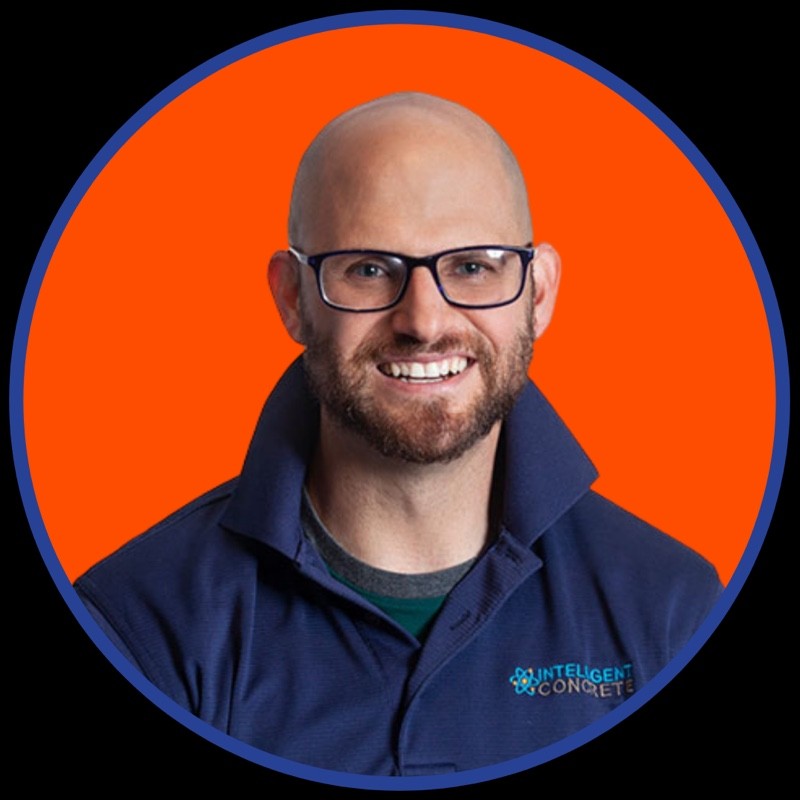
Jon Belkowitz is the CEO of EDYSTON, LLC and CTO at Intelligent Concrete, LLC. Before Intelligent Concrete, LLC, he served in the United States Air Force from 1996 to 2006 specializing in Civil Engineering. His tour of duty introduced Dr. Belkowitz to a wide variety of concrete types and uses which were dependent upon the engineering practices of different host nation forces, developing nations, and disaster repair initiatives. Jon has worked in private laboratories on structural engineering and materials development projects to include the application of nanotechnology in concrete. Dr. Belkowitz has worked as a consultant on projects in the United States, India, Turkey, Africa, Italy, New Zealand, Australia, and Germany. Jon has worked as Chief of Materials for a 3D concrete printing firm, an advisor for NASA on 3D printing of concrete holds patent applications on 3D printing with concrete, and is an ACI member on the subject. Jon received his Masters of Mat Science from the University of Denver and his Ph.D. in Mechanical Engineering with a specialty in Nanotechnology in Concrete at Stevens Institute of Technology in New Jersey. Jon is a licensed Professional Engineer in Colorado and Maryland.









